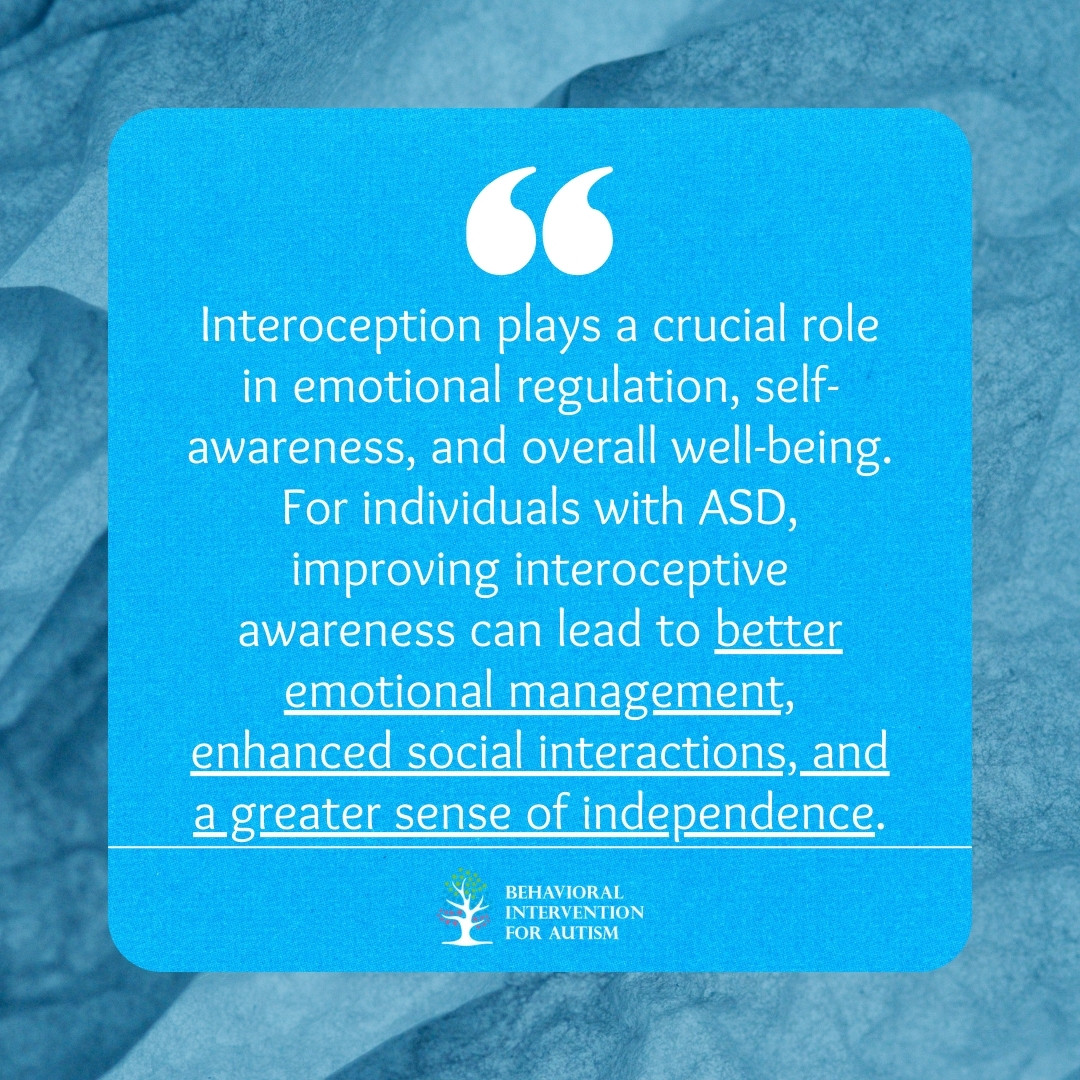
Table of Contents
Autism Spectrum Disorder (ASD) is a condition that impairs social communication, interactions, and behavior patterns. Individuals with ASD often experience sensory processing differences, including challenges with how they perceive and respond to sensory stimuli. One area of sensory processing that plays a critical role in understanding ASD and its impact on mental health is interoception—the ability to perceive internal bodily sensations.
Interoception is the sense that allows individuals to recognize and interpret signals from their internal organs, such as thirst, hunger,, and pain. These internal cues are essential for emotional regulation, self-awareness, and overall well-being. However, individuals with ASD may experience differences in interoception, leading to difficulties in managing emotions and understanding their bodily states.
In this article, we will delve into the relationship between ASD and interoception, exploring how these sensory processing differences impact daily life. By understanding this connection, we can better support individuals with ASD in developing strategies for self-regulation and improving their quality of life.
What is Interoception?
Interoception refers to the brain’s ability to perceive and process signals from within the body. These signals come from various internal organs, including the heart, lungs, stomach, and intestines. Interoception plays a significant role in helping individuals recognize physical states, such as hunger, thirst, temperature, or the need to use the restroom.
In addition to these basic physical sensations, interoception is also involved in emotional experiences. The internal sensations linked to emotions—such as the feeling of a racing heart during anxiety or a fluttering stomach in moments of excitement—are processed through interoception. This awareness allows individuals to identify and label their emotions and adjust their behavior accordingly.
For individuals with ASD, interoception may not function in the same way as it does in individuals without ASD. This difference can lead to challenges in understanding or responding to internal bodily cues, making it harder to manage emotional states and physical needs.
The Link Between ASD and Interoception
Research has shown that individuals with ASD often experience difficulties with sensory processing, and interoception is no exception. These challenges can manifest in various ways, such as difficulty identifying when they are hungry, feeling overwhelmed by sensory inputs, or struggling to recognize the physical symptoms of emotions like anxiety or excitement.
One reason for these challenges is that the brain’s processing of interoceptive signals can be less accurate or less finely tuned in individuals with ASD. For example, they may not be able to detect subtle changes in heart rate or respiration, making it difficult to recognize when they are becoming anxious or overstimulated. As a result, individuals with ASD may struggle to self-regulate their emotions or manage physical needs effectively.
Furthermore, interoception is closely linked to executive function, which refers to cognitive processes involved in planning, decision-making, and self-control. Difficulty processing interoceptive signals can lead to challenges in regulating behavior, particularly in high-stress situations. This can result in meltdowns, difficulties with communication, or other behavioral issues that are commonly seen in individuals with ASD.
Understanding the link between ASD and interoception is critical for developing effective interventions and support strategies for individuals on the autism spectrum.
Sensory Processing Challenges in ASD
Sensory processing challenges are a hallmark of ASD, affecting how individuals perceive and respond to both external and internal stimuli. These challenges can be particularly pronounced when it comes to interoception, as individuals with ASD may have difficulty interpreting the signals from their internal organs.
For example, a child with ASD might not recognize the physical sensation of a full bladder or may fail to identify the signs of hunger, leading to difficulty eating or using the bathroom appropriately. Similarly, they may struggle to recognize when they are becoming overwhelmed or anxious, resulting in an emotional outburst or withdrawal from social situations.
These sensory processing challenges are not limited to interoception alone. Many individuals with ASD also experience hypersensitivity or hyposensitivity to external stimuli, such as lights, sounds, or textures. This heightened or diminished sensitivity can make it even more difficult to manage internal bodily signals, as the brain is already overloaded with external sensory information.
To help individuals with ASD better manage these sensory processing challenges, it is important to incorporate strategies that focus on both interoception and other sensory needs. These strategies can include sensory integration therapy, mindfulness techniques, and environmental modifications to reduce sensory overload.
Impact of Interoception on Emotional Regulation
Interoception plays a crucial role in emotional regulation, as the ability to interpret and respond to bodily sensations is closely tied to how we manage our emotions. For individuals with ASD, difficulties with interoception can lead to challenges in recognizing and understanding their emotions.
For example, someone with ASD might experience physical sensations like a racing heart or tense muscles but may not immediately recognize these sensations as signs of anxiety or stress. As a result, they may not know how to respond appropriately, leading to difficulties in managing anxiety or frustration.
Without the ability to recognize these internal signals, individuals with ASD may become overwhelmed and engage in behaviors such as aggression, self-injury, or withdrawal. These behaviors are often a way of coping with the emotional turmoil caused by unrecognized or poorly understood bodily sensations.
Interventions that focus on improving interoceptive awareness can help individuals with ASD better understand their emotions and learn more effective strategies for emotional regulation. For example, therapies such as the Zones of Regulation and mindfulness-based interventions can help individuals tune in to their bodily signals and learn how to manage their emotions in a healthy and adaptive way.
Strategies for Improving Interoception in Individuals with ASD
Improving interoception in individuals with ASD requires a multifaceted approach that combines education, therapeutic techniques, and environmental modifications. By enhancing interoceptive awareness, individuals with ASD can develop a better understanding of their physical and emotional states, leading to improved self-regulation and emotional well-being.
1. Sensory Integration Therapy
Sensory integration therapy is a common treatment for sensory processing difficulties, including interoception. This therapy uses various sensory activities to help individuals become more aware of their internal bodily sensations and improve their ability to interpret these signals.
For example, a therapist may use activities that involve deep pressure, movement, or proprioception to help individuals connect with their body and develop a better sense of where they are in space. These activities can help individuals with ASD recognize and respond to interoceptive signals such as changes in heart rate, temperature, or muscle tension.
2. Mindfulness and Body Awareness Techniques
Mindfulness and body awareness techniques are also effective tools for improving interoception in individuals with ASD. These practices focus on paying attention to bodily sensations in the present moment, which can help individuals develop greater awareness of their internal states.
For example, deep breathing exercises, body scans, and mindful movement practices can help individuals with ASD become more attuned to their interoceptive signals. These techniques can also promote relaxation and emotional regulation, helping individuals manage stress and anxiety more effectively.
3. Visual Supports and Self-Monitoring Tools
Visual supports, such as emotion charts, body maps, or visual schedules, can be useful tools for helping individuals with ASD identify and understand their internal states. By providing a visual representation of different emotions or bodily sensations, these tools can help individuals connect their physical experiences with their emotional experiences.
Self-monitoring tools, such as checklists or apps that track physical sensations or emotions, can also be beneficial. These tools encourage individuals to check in with their internal states throughout the day, helping them become more aware of changes in their body and emotions.
4. Environmental Modifications
Creating a sensory-friendly environment is another important strategy for supporting individuals with ASD. By reducing sensory overload and creating a calm, predictable space, individuals can better focus on their internal signals without being distracted or overwhelmed by external stimuli.
For example, using soft lighting, noise-reducing headphones, and tactile-friendly furniture can help individuals with ASD feel more comfortable and focused. This can also support emotional regulation, as individuals are less likely to experience sensory overload that may interfere with their ability to recognize and respond to interoceptive signals.
Understanding the connection between ASD and interoception is essential for providing effective support to individuals on the autism spectrum. By recognizing the sensory processing challenges that individuals with ASD face, we can develop strategies that help improve their ability to interpret and respond to internal bodily signals.

Through targeted therapies, mindfulness practices, and environmental modifications, we can support individuals with ASD in developing a better understanding of their internal states. By promoting interoceptive awareness, we help individuals with ASD navigate the world with greater ease and confidence, leading to improved quality of life.
Learn More About Interoception and ASD
Interoception is the ability to sense internal bodily states, such as hunger or tiredness, which can be challenging for individuals with ASD. These difficulties may impact emotional regulation and self-awareness. By understanding these challenges, we can better support those with autism in improving their self-awareness and overall well-being. Behavioral Intervention For Autism provides tailored ABA programs in Florida that focus on enhancing skills like interoception. Our experienced team works closely with each individual to create personalized strategies that promote growth and independence. Interested in exploring how our services can support your loved one? Contact us today for more information!
Sources:
https://neurodivergentinsights.com/blog/autism-interoception
https://www.autism.org.uk/advice-and-guidance/professional-practice/interoception-wellbeing
https://reframingautism.org.au/interoception-knowing-yourself-inside-and-out/
- 9 Common Obsessions of Children With Autism You Should Know - February 25, 2025
- What is Neurodiversity? A Guide to Embracing Differences - February 25, 2025
- Understanding Hyperfocus in Autism: What It Means and Why It Happens - February 25, 2025

